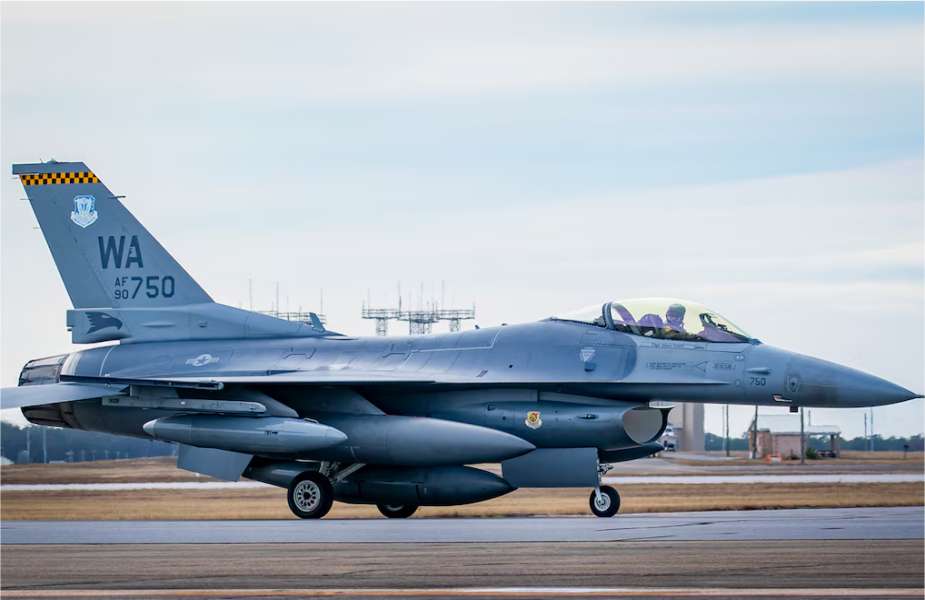Breaking news
US Converts F-16 Fighter into Unmanned Aircraft with Latest Modifications.
On April 1, 2024, the 96th and 53rd Wings at Eglin Air Force Base welcomed the first batch of three F-16 Fighting Falcons, paving the way for their participation in the innovative Viper Experimentation and Next-gen Operations Model - Autonomy Flying Testbed (VENOM-AFT) initiative. This program aims, among other things, to accelerate the evaluation of unmanned flight software for the F-16s.
Follow Army Recognition on Google News at this link

The VENOM-AFT is designed and funded to accelerate the testing of autonomy software on crewed and uncrewed aircraft. (Picture source: US DoD)
VENOM-AFT is a strategic program, supported by significant investment, aimed at speeding up the assessment of autonomous flight software across both manned and unmanned aircraft. This initiative builds upon the existing foundations of autonomy and artificial intelligence research at Eglin Air Force Base, enhancing the collaborative combat aircraft initiative and providing essential insights to developers working on autonomous technologies.
The next phase involves adapting these F-16s into experimental platforms to facilitate the rapid evaluation of autonomous flight functionalities.
Major Ross Elder, the VENOM development test lead, emphasized the importance of the program in advancing aerial combat technologies. He highlighted its potential to introduce groundbreaking autonomous capabilities for both existing and future aircraft, steering the future of aviation toward unprecedented horizons.
The testing process for the VENOM initiative will follow established procedures for F-16 and F-15 evaluations at Eglin, involving both the 40th Flight Test Squadron and the 85th Test and Evaluation Squadron in developmental and operational assessments.
Lieutenant Colonel Jeremy Castor, in charge of operational testing for VENOM, pointed out the benefits of conducting both types of tests in close proximity, such as improved collaboration and streamlined exchange of insights and experiences. Throughout these trials, pilots will oversee the autonomous systems from the cockpit to ensure that the aircraft meets its testing objectives and that all flight and mission protocols are adhered to.
Lieutenant Colonel Joe Gagnon, commander of the 85th TES, clarified the ongoing role of pilots in these tests, emphasizing the continuous involvement of a human element to supervise and control autonomous operations, thus maintaining a "human-in-the-loop" approach. Feedback from operators during and after flights will be crucial for refining the autonomous systems, ensuring they make sound decisions throughout the mission.
The F-16 Fighting Falcon, a masterpiece originally from General Dynamics and now produced by Lockheed Martin, is a multi-role aircraft that has been in service since its first flight on February 2, 1974, and its commissioning on August 17, 1978. To date, more than 4,588 units have been built, attesting to its popularity and efficiency. The cost of an F-16A is around 20 million dollars.
At the heart of this aircraft is a Pratt & Whitney F100-PW-229 turbofan engine, delivering a thrust of 79 kN without afterburner and up to 130 kN with. With a wingspan of 9.8 meters, a length of 14.8 meters, and a height of 4.8 meters, the F-16 has a wing area of 27.87 m². Its weight ranges from 8,272 kg empty to a maximum of 16,900 kg, depending on the armament and fuel carried. These characteristics enable it to reach a maximum speed of 2,173 km/h (Mach 2.04), with an operational ceiling of 15,200 meters and a range of 550 km.
In terms of armament, the F-16 is equipped with an internal M61A1 Vulcan 20 mm cannon and can carry various air-to-air and air-to-ground missiles, including the AIM-7 Sparrow, Sidewinder, and anti-radar HARM missiles, as well as guided and unguided bombs. Its thrust-to-weight ratio of 0.90 and wing loading of 431 kg/m² provide excellent performance in air combat and ground attack.
Its proliferation and the quantity produced make it an excellent choice for automation. The advancements made in this area by the United States could interest a large number of countries around the world, including Ukraine, which is set to receive a certain quantity of these aircraft.
The ultimate goal of the VENOM initiative is to propel the Air Force's knowledge and capabilities in autonomous technology and weaponry forward, as emphasized by Gagnon, who focused on the objective of achieving rapid deployment and operational readiness of these technologies in a safe manner.























